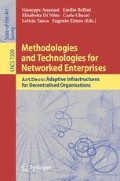Abstract
The technological dimension and the organizational dimension are the two faces of Information Technology (IT) revolution shaping the life of large and small firms in last 50 years, from the first adoption of mainframe and reusable software to the recent integration of hardware and software technologies within Internet of Things. Over the last few decades, a number of scholars coming from computer science and from organization theory shared a deep confidence on the magic power of networks, especially of technological networks, more and more fast and reliable, and of organizational networks, more and more effective in balancing cooperation and competition among firms. Coherently with the aim of this volume, in this chapter we assume a more critical perspective deriving from the joint analysis of organizational challenges and of technological opportunities for networked enterprises aimed at developing new products/services. The management of innovation within networked enterprises requires a strategic approach to many dimensions. In this chapter we apply at open-closed trade-off the model developed by Pisano & Verganti in the paper Which kind of Collaboration is Right for You published by Harvard Business Review in December 2008. In the Chapter 4 we will focus the strategic models aimed at managing the new product development within the networked enterprise modelled as a design discourse. In the Chapter 5 authors will propose a third strategic perspective, proposing the application of a platform strategy in order to promote the a doption of advanced network infrastructures by Small and Medium Enterprises (SMEs).
Access this chapter
Tax calculation will be finalised at checkout
Purchases are for personal use only
Preview
Unable to display preview. Download preview PDF.
References
Abernathy, W., Clark, K.: Innovation: mapping the winds of creative destruction. Research Policy (14) (1985)
Adler, P.: Market, hierarchy, and trust: the knowledge economy and the future of capitalism. Organization Science (12), 215–234 (2001)
Bellini, E., Canonico, P.: Knowing communities in project driven organizations: Analysing the strategic impact of socially constructed hrm practices. International Journal of Project Management (IJPM) (26), 44–50 (2008)
Bellini, E., Dell’ Era, C.: How can product semantics be embedded in product technologies? the case of the italian wine industry. International Journal of Innovation Management (IJIM) (3) (2009)
Blackler, F.: Epliogue: Knowledge, knowledge work and organizations. The Strategic Management of Intellectual Capital and Organizational Knowledge (2002)
Chesbrough, H.: Open innovation: the new imperative for creating and profiting from technology. Harward Business School Press, Boston (2003)
Chesbrough, H.W., Vanhaverbeke, W., West, J.: Open innovation: Researching a new paradigm. Oxford University Press, Oxford (2006)
Choo, C., Bontis, N. (eds.): Sense making, knowledge creation and decision making: organizational knowing and emergent strategy. Oxford University Press, Oxford (2002)
Christensen, C., Rosembloom, R.: Explaining the attacker’s advantage: technological paradigms, organizational dynamics and the value network. Research Policy (24), 233–257 (2006)
Colombo, M.G.: The changing boundaries of the firm (1998)
Davies, S., Meyer, C.: Blur: The speed of change in the connected economy (1998)
Friedberg, E.: Le pouvoir et la régle. Le Seuil, Paris (1993)
Galbraith, J.: Designing complex organizations. Addison-Wesley Publishing Co, Reading (1973)
Gambetta, D.: Trust: Making and breaking cooperative relations (1988)
Gassman, O.: Opening up the innovation process: towards an agenda. R&D Management 36(3) (2006)
Giddens, A.: The constitution of society: Outline of the theory of structure. University of California Press, Berkeley (1984)
Goffmann, E.: Frame analyses. Harper and Row, New York (1984)
Hertog, J., Huizenga, E.: The knowledge enterprise: Implementation of intelligent business strategies (2000)
Itami, H., Numagami, T.: Knowing in practice: Enacting a collective capability in distributed organizing. Organizational Science (3), 119–136 (2002)
Kodama, F.: Technology fusion and the new r&d. Harvard Business Review (1992)
Miotti, L., Sachwald, F.: Co-operative r&d: Why and with whom? an integrated framework of analysis. Research Policy 32(8) (2003)
Orlikowski, W.: The duality of technology: Rethinking the concept of technology in organizations. Organizational Science 3(3) (1992)
Orlikowski, W.: Using technology and constituting structures: A practice lens for studying technology in organizations. Organizational Science 11(4) (2000)
Pisano, G., Verganti, R.: Which kind of collaboration is right for you? Harvard Business Review (12), 78–86 (2008)
Powell, W., Koput, K., Smith-Doerr, L.: Interorganisational collaboration and the locus of innovation: Networks of learning. Administrative Science Quarterly (41) (1996)
Verganti, R.: Innovating through design. Harvard Business Review (12), 114–122 (2006)
Verganti, R.: Design, meanings and radical innovation: A metamodel and a research agenda. Journal of Product Innovation Management (25), 435–456 (2008)
Raffa, M., Zollo, G.: Sources of innovation and professionals in small innovative firms. International Journal of Technology Management 9(3-4) (2009)
Schonsleben, P., Buchel, A.: Organising the extended enterprise. Journal of Product Innovation Management (2008)
Seybold, P.: Get inside the lives of your customers (2001)
Stein, E., Iansiti, M.: Understanding user needs (1995)
Thomke, S., Von Hippel, E.: Customers as innovators: a new way to create value. Harvard Business Review, 47–56 (2002)
Tonchia, S., Tramontano, A.: Process management for the extended enterprise: organizational and ict networks (2004)
Tushman, M., Anderson, P.: Technological discontinuities and organizational environment. Administrative Science Quarterly (3), 439–465 (1986)
Tushman, M., Anderson, P.: Technological discontinuities and dominant designs: a cyclic model of technological change (35) (1990)
Venkatraman, N., Henderson, J.: Real strategies for virtual organizing. Sloan Management Review (Fall 1998)
Weick, K.: The social psychology of organizing. Addison- Wesley, MA (1979)
Wenger, E., Snyder, W.: Communities of practice: The organizational frontier. Harvard Business Review (78) (2000)
Williamson, O.: Comparative economic organization: The analysis of discrete structural alternatives. Administrative Science Quarterly (36) (1991)
Author information
Authors and Affiliations
Editor information
Editors and Affiliations
Rights and permissions
Copyright information
© 2012 Springer-Verlag Berlin Heidelberg
About this chapter
Cite this chapter
Bellini, E. (2012). Which Collaboration Strategy for the Networked Enterprise in Wine Industry? Technological and Organizational Challenges. In: Anastasi, G., Bellini, E., Di Nitto, E., Ghezzi, C., Tanca, L., Zimeo, E. (eds) Methodologies and Technologies for Networked Enterprises. Lecture Notes in Computer Science, vol 7200. Springer, Berlin, Heidelberg. https://doi.org/10.1007/978-3-642-31739-2_3
Download citation
DOI: https://doi.org/10.1007/978-3-642-31739-2_3
Publisher Name: Springer, Berlin, Heidelberg
Print ISBN: 978-3-642-31738-5
Online ISBN: 978-3-642-31739-2
eBook Packages: Computer ScienceComputer Science (R0)

